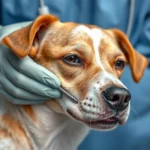
Introduction
ACL injuries in dogs are a common concern among pet owners. The anterior cruciate ligament (ACL) plays a crucial role in stabilizing the knee joint, allowing for smooth and coordinated movements. When a dog suffers a torn ACL, it can lead to significant pain and mobility issues. This injury can arise from various causes such as high-impact activities, obesity, or simply the aging process. Understanding this injury is essential for providing the best care for your furry friend.
Seeking veterinary advice is vital for accurately diagnosing and effectively treating a torn ACL. A veterinarian can offer insights into recovery options and outline the best path forward for your dog. In this article, we will explore the nature of ACL injuries, treatment options, recovery timelines, and preventive measures to ensure your dog’s joint health remains intact.
Understanding ACL Injuries
What is a Torn ACL?
A torn ACL in dogs refers to a rupture of the anterior cruciate ligament in the knee. This injury can lead to instability in the joint, causing a dog to experience pain and difficulty in movement. Common symptoms of a torn ACL include:
- Limping or favoring one leg
- Swelling around the knee joint
- Difficulty in jumping or climbing stairs
- Audible sounds (like popping) during movement
- Reluctance to engage in physical activities
It’s crucial to recognize these symptoms early and consult with a veterinarian for a proper diagnosis.
Causes of ACL Injuries
Intrinsic Factors: Certain dogs are predisposed to ACL injuries due to their age, breed, and genetic factors. Breeds such as Labrador Retrievers, Rottweilers, and German Shepherds are particularly susceptible. As dogs age, their ligaments weaken, making them more vulnerable to injuries.
Extrinsic Factors: External factors also play a significant role in ACL injuries. Dogs that lead sedentary lifestyles or engage in high-impact activities are at higher risk. Environmental hazards, such as slippery floors, can contribute to sudden injuries, emphasizing the importance of a safe living space for your pet.
Diagnosis of a Torn ACL
Veterinary Examination
The first step in diagnosing a torn ACL is a thorough veterinary examination. Veterinarians typically begin with an initial assessment that includes:
- Observing the dog’s gait and mobility
- Manipulating the knee joint to assess stability
- Checking for signs of pain and swelling
Diagnostic Tests
Following the initial assessment, veterinarians may recommend diagnostic tests to confirm the injury. X-rays are commonly used to identify any structural issues in the joint and to rule out other conditions, such as osteoarthritis or fractures. In some cases, advanced imaging techniques like an MRI may be necessary for a comprehensive evaluation.
Treatment Options
Conservative Management
Not all torn ACLs require surgery. Conservative management can be an effective treatment option for certain cases, particularly in less active dogs or those with partial tears. Key components of conservative management include:
- Rest and Rehabilitation: Limiting your dog’s activity is essential in the early stages of recovery. Gradually reintroducing activity can help strengthen the knee without causing further injury.
- Physical Therapy: Engaging in therapeutic exercises tailored to your dog’s needs can aid recovery. Techniques may include hydrotherapy, massage, and specific exercises designed to improve strength and flexibility in the joint.
Surgical Options
For many dogs, surgery may be the best solution for a torn ACL. Several surgical techniques can be employed, including:
- Tibial Plateau Leveling Osteotomy (TPLO): This procedure alters the mechanics of the knee joint, providing stability and allowing dogs to return to their normal activities.
- Extracapsular Repair: This technique involves placing a suture around the knee to stabilize the joint. It’s often used in smaller dogs or those with less severe injuries.
Post-Surgical Care is crucial for successful recovery. This includes:
- Managing your dog’s pain through medication as prescribed by the vet.
- Implementing a rehabilitation program that gradually increases activity levels.
- Regular check-ups with the vet to monitor healing progress.
Recovery Process
Timeline for Recovery
The timeline for recovery from a torn ACL can vary significantly based on several factors, including:
- The severity of the injury
- The age and weight of the dog
- The type of treatment chosen
Generally, the recovery process can take anywhere from 6 to 12 months. In the early stages, expect to limit your dog’s activity significantly, followed by a gradual increase in exercise as healing progresses.
Signs of Successful Recovery
Recognizing the signs of successful recovery is vital. Indicators that your dog is healing well include:
- Improved mobility and range of motion
- Decreased swelling and pain
- Ability to engage in regular activities without discomfort
Regular follow-up visits to the vet will help ensure that your dog is on track for a full recovery and can help catch any potential complications early.
Preventing Future ACL Injuries
Lifestyle Adjustments
Preventing future ACL injuries is largely about maintaining your dog’s overall health. Weight management is crucial, as excess weight can place additional strain on the joints. Consulting with your veterinarian about a balanced diet and appropriate portion sizes can help maintain a healthy weight.
Exercise routines should also be tailored to support joint health. Engaging in low-impact activities, such as swimming or walking on a leash, can strengthen the muscles around the joints while minimizing the risk of injury.
Regular Veterinary Check-Ups
Regular vet visits are essential for monitoring your dog’s joint health, especially in breeds predisposed to ACL injuries. Your veterinarian can assess your dog’s overall physical condition and suggest preventative measures to keep their joints healthy.
Frequently Asked Questions (FAQs)
Can all dogs with a torn ACL recover?
Most dogs can recover from a torn ACL with appropriate treatment, whether conservative management or surgery. Recovery success largely depends on the severity of the injury and how promptly it is addressed.
How long does rehabilitation take?
Rehabilitation can take anywhere from 6 to 12 months, depending on the treatment type and the dog’s individual healing process. Consistent follow-up with your veterinarian is vital during this phase.
What happens if the ACL injury goes untreated?
Untreated ACL injuries can lead to chronic pain, reduced mobility, and the potential for further joint damage, including arthritis. Prompt veterinary care is essential to avoid long-term complications.
Conclusion
Understanding that a dog can recover from a torn ACL is essential for any pet owner facing this challenging situation. The role of the veterinarian is crucial in diagnosing and managing this injury, ensuring a well-planned recovery process. By adhering to veterinary advice and implementing preventive measures, you can help ensure your dog enjoys a healthy and active life, free from the limitations of joint pain.
If your dog shows signs of a torn ACL, consulting a vet for personalized advice is the best course of action. Their expertise can guide you through the complexities of treatment and recovery, ultimately supporting your dog’s journey back to health.









